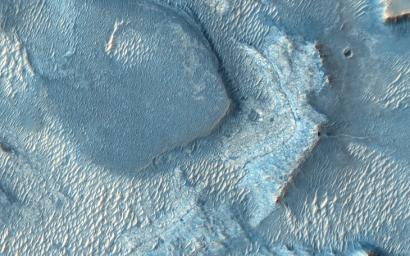
|
A Large, Banded Angular Fragment in Nili Fossae
- Click the image above for a larger view
- Full-Res JPEG (2880 x 1800) (963.6 kB)
- Full-Res TIFF (2880 x 1800) (15.6 MB)
Caption:

Map Projected Browse Image
Click on the image for larger version
In a Context Camera (CTX) image, there is a large angular fragment that appears to have light and dark-toned bands. HiRISE images of similar fragments nearby also show this banding, and the resolution of our camera may help determine what these layers are.
Nili Fossae was once considered a potential landing spot for the Mars Science Laboratory, and has one of the largest, most diverse exposures of clay minerals. Clay minerals contain water in their mineral structure and may preserve organic materials.
Background Info:
HiRISE is one of six instruments on NASA's Mars Reconnaissance Orbiter. The University of Arizona, Tucson, operates HiRISE, which was built by Ball Aerospace & Technologies Corp., Boulder, Colo. NASA's Jet Propulsion Laboratory, a division of the California Institute of Technology in Pasadena, manages the Mars Reconnaissance Orbiter Project for NASA's Science Mission Directorate, Washington.
Cataloging Keywords:
| Name | Value | Additional Values |
|---|---|---|
| Target | Mars | |
| System | ||
| Target Type | Planet | |
| Mission | Mars Reconnaissance Orbiter (MRO) | Mars Science Laboratory (MSL) |
| Instrument Host | Mars Reconnaissance Orbiter | Curiosity Rover |
| Host Type | Orbiter | Rover |
| Instrument | High Resolution Imaging Science Experiment (HiRISE) | |
| Detector | ||
| Extra Keywords | Color, Map, Water | |
| Acquisition Date | ||
| Release Date | 2014-03-26 | |
| Date in Caption | ||
| Image Credit | NASA/JPL-Caltech/Univ. of Arizona | |
| Source | photojournal.jpl.nasa.gov/catalog/PIA17909 | |
| Identifier | PIA17909 | |
